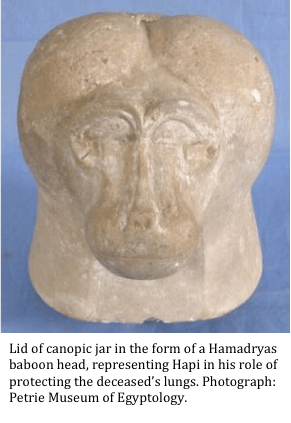Musical Apes: Can Baboons Play the Harp?
By Gemma Angel, on 11 February 2013
 by Suzanne Harvey
by Suzanne Harvey
Excuse me, is that baboon playing a harp?
This is a question that I long to be asked when I’m working at the Petrie Museum of Egyptology. Whilst there are many examples of baboon figurines in the collection, my favourites have always been the selection from Amarna, in which the animals are shown performing acrobatics, drinking beer and playing the harp. Baboons appear throughout Egyptian mythology, and the majority of the figurines at the Petrie and elsewhere depict baboons sitting in a realistic manner, rather than performing any elaborate tricks. These figurines are often found at burial sites. Hapi, an Egyptian God of the underworld, is depicted with the head of a Hamadryas baboon and is said to protect the lungs of the deceased.[1] For this reason, it is common to find the baboon head of Hapi as a lid of canopic jars containing lungs. So, if baboons are typically viewed as sacred animals used in funerary reliquary, why is that baboon playing a harp?
 Monkeys of several species were kept as pets in Ancient Egypt, so it is possible that they were trained to perform tricks. Having studied olive baboon infant tantrums, I know from experience that they are athletic animals who are often keen to throw themselves around – but acrobatics seems a stretch, and whilst I’m sure they could be trained to pluck harp strings, I doubt it would be easy listening. Since my own biological and behavioural approach does little but rule out possibilities, there must be another explanation for the existence of these unusual figurines. The Petrie Museum attracts a lot of visitors who are either professional Egyptologists or well-read enthusiasts of the subject. So, in my first ever research engager micro crowd-sourcing exercise, I’ve compiled some of their theories here:
Monkeys of several species were kept as pets in Ancient Egypt, so it is possible that they were trained to perform tricks. Having studied olive baboon infant tantrums, I know from experience that they are athletic animals who are often keen to throw themselves around – but acrobatics seems a stretch, and whilst I’m sure they could be trained to pluck harp strings, I doubt it would be easy listening. Since my own biological and behavioural approach does little but rule out possibilities, there must be another explanation for the existence of these unusual figurines. The Petrie Museum attracts a lot of visitors who are either professional Egyptologists or well-read enthusiasts of the subject. So, in my first ever research engager micro crowd-sourcing exercise, I’ve compiled some of their theories here:
 1. The figurines were crafted at a time when the Pharaoh Akhenaten brought in monotheism, demanding that his subjects worship only one God, the Sun God. Therefore, worship of the baboon God was forbidden, and these less serious depictions of baboons may have become fashionable – Suggested by a retired German doctor who researches the beginnings of monotheism in ancient cultures as a hobby.
1. The figurines were crafted at a time when the Pharaoh Akhenaten brought in monotheism, demanding that his subjects worship only one God, the Sun God. Therefore, worship of the baboon God was forbidden, and these less serious depictions of baboons may have become fashionable – Suggested by a retired German doctor who researches the beginnings of monotheism in ancient cultures as a hobby.
2. They are part of a culture of fantastical animal stories used for entertainment, and would have been high status decorations in a wealthy household – Suggested by an American Professor of art, interested in representations of animals in Egypt.
3. As baboons, particularly alpha males, could be seen as the reincarnation of dead ancestors in the form of the baboon deity Babi (not to be confused with the baboon-headed deity, Hapi…) the statues may show baboons engaged in activities that dead relatives enjoyed – Suggested by a UCL masters student studying ancient writing.
 Any or all of these theories may be relevant, but overall, it seems that perspectives from art, theology and graphology lead to more interesting interpretations of this object than my own biological anthropology approach. For anyone interested in cross-disciplinary or multiple interpretations of museum objects, our upcoming exhibition Foreign Bodies will be on display in UCL’s North Cloisters, with additional featured objects in all 3 of the UCL Museums from March 18th – featuring (amongst others) my favourite baboon harpist.
Any or all of these theories may be relevant, but overall, it seems that perspectives from art, theology and graphology lead to more interesting interpretations of this object than my own biological anthropology approach. For anyone interested in cross-disciplinary or multiple interpretations of museum objects, our upcoming exhibition Foreign Bodies will be on display in UCL’s North Cloisters, with additional featured objects in all 3 of the UCL Museums from March 18th – featuring (amongst others) my favourite baboon harpist.
References:
[1] Hans Kummer: In Quest of the Sacred Baboon. (1995), Chichester: Princeton University Press.
 Close
Close

